
An envelope is a common packaging item, usually made of thin, flat material. It is designed to contain a flat object, such as a letter or card.

Waxed paper is paper that has been made moisture-proof and grease-proof through the application of wax.

A hardcover, hard cover, or hardback book is one bound with rigid protective covers. It has a flexible, sewn spine which allows the book to lie flat on a surface when opened. Modern hardcovers may have the pages glued onto the spine in much the same way as paperbacks. Following the ISBN sequence numbers, books of this type may be identified by the abbreviation Hbk.

A firecracker is a small explosive device primarily designed to produce a large amount of noise, especially in the form of a loud bang, usually for celebration or entertainment; any visual effect is incidental to this goal. They have fuses, and are wrapped in a heavy paper casing to contain the explosive compound. Firecrackers, along with fireworks, originated in China.

Paperboard is a thick paper-based material. While there is no rigid differentiation between paper and paperboard, paperboard is generally thicker than paper and has certain superior attributes such as foldability and rigidity. According to ISO standards, paperboard is a paper with a grammage above 250 g/m2, but there are exceptions. Paperboard can be single- or multi-ply.

Luc Montagnier was a French virologist and joint recipient, with Françoise Barré-Sinoussi and Harald zur Hausen, of the 2008 Nobel Prize in Physiology or Medicine for his discovery of the human immunodeficiency virus (HIV). He worked as a researcher at the Pasteur Institute in Paris and as a full-time professor at Shanghai Jiao Tong University in China.
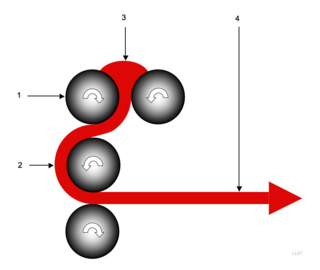
A calender is a series of hard pressure rollers used to finish or smooth a sheet of material such as paper, textiles, rubber, or plastics. Calender rolls are also used to form some types of plastic films and to apply coatings. Some calender rolls are heated or cooled as needed. Calenders are sometimes misspelled calendars.

Tracing paper is paper made to have low opacity, allowing light to pass through. Its origins date back to at least the 1300s where it was used by artists of the Italian Renaissance. In the 1880s, tracing paper was produced en masse, used by architects, design engineers, and artists. Tracing paper was key in creating drawings that could be copied precisely using the diazo copy process. It then found many other uses. The original use for drawing and tracing was largely superseded by technologies that do not require diazo copying or manual copying of drawings.
Various measures of paper quantity have been and are in use. Although there are no S.I. units such as quires or bales, there are ISO and DIN standards for the ream. Expressions used here include U.S. Customary Units.
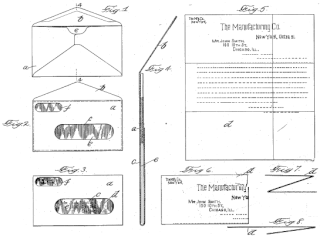
A windowed envelope is a conventional envelope with a transparent window to allow the recipient's address to be printed on the paper contained within.

Stockbooks are storage books used by stamp collectors for storage of postage stamps placed in pockets, on pages, for easy viewing. Other philatelic items, such as plate blocks, miniature sheets, covers, lettersheets, etc., can be stored in stockbooks.
Geobios is an academic journal published bimonthly by the publishing house Elsevier. Geobios is an international journal of paleontology, focusing on the areas of palaeobiology, palaeoecology, palaeobiogeography, stratigraphy and biogeochemistry.
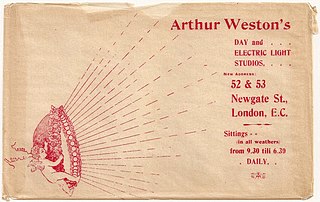
Glassine is a smooth and glossy paper that is air-, water-, and grease-resistant. It is usually available in densities between 50–90 g/m2 (0.010–0.018 lb/sq ft). It is translucent unless dyes are added to color it or make it opaque. It is manufactured by supercalendering: after pressing and drying, the paper web is passed through a stack of alternating steel- and fiber-covered rolls called a supercalender at the end of the paper machine so that the paper fibers flatten facing in the same direction.
Mark R. Geier is an American former physician and controversial professional witness who testified in more than 90 cases regarding allegations of injury or illness caused by vaccines. Since 2011, Geier's medical license has been suspended or revoked in every state in which he was licensed over concerns about his autism treatments and his misrepresentation of his credentials to the Maryland Board of Health, where he falsely claimed to be a board-certified geneticist and epidemiologist.

Parchment paper, vegetable parchment, or, baking paper is a cellulose-based composite that has been processed to give it additional properties including non-stickiness, grease resistance, and resistance to humidity. It is commonly used in baking as a disposable non-stick, grease resistant surface. It should not be confused with waxed paper, which is paper that has been coated in wax.
Cardboard is a generic term for heavy paper-based products. The construction can range from a thick paper known as paperboard to corrugated fiberboard which is made of multiple plies of material. Natural cardboards can range from grey to light brown in color, depending on the specific product; dyes, pigments, printing, and coatings are available.
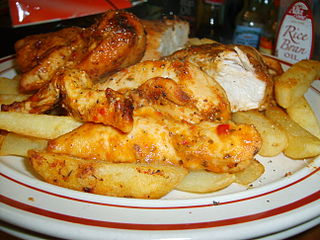
Chicken and chips is a combination of foods predominantly consumed in the United Kingdom, The Commonwealth, and United States. It consists of a piece of fried, roasted, or barbecued chicken and chips, or French fries as they are known elsewhere. The consumption of chicken and chips is a popular food choice based on its value for money. In some cities, such as London, on most high streets there are at least one or two chicken and chip shops, amongst kebab, pizza, Chinese, and Indian take-away shops. Other names for chicken and chips include: Chicken fingers, chicken tenders, chicken nuggets and fries.
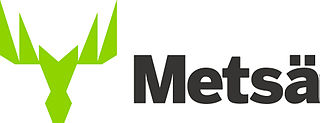
Metsä Tissue is a Finnish company headquartered in Espoo that manufactures tissue papers and greaseproof papers. Metsä Tissue sells its products under brands Lambi, Serla, Mola, Tento, Katrin and SAGA. In Sweden, they have paper mills in Mariestad, Kvillsfors, and Pauliström. In Finland, Metsä Tissue has one mill located in Mänttä. In Germany Metsä Tissue has three mills located in Raubach, Kreuzau and Düren. Metsä Tissue also has mills in Krapkowice, Poland and Zilina, Slovakia. It has a total of nine paper mills, all in Europe. Metsä Tissue is part of Metsä Group, one of the largest forest industry groups in the world. The company's operations in Russia ended in 2015.

Mahim halwa is an Indian sweet named after Mahim, an area in Mumbai. It is also known as Ice Halwa. It is named so because it was created by the sweetmeat makers Joshi Budhakaka from Mahim. It is a food speciality that Mumbai is famous for. It has been described as a "unique confection of thin layers of sweet dough pressed into compact squares and separated by sheets of greaseproof paper". A 2010 news story reported attempts to obtain geographical indication registration for the sweet.
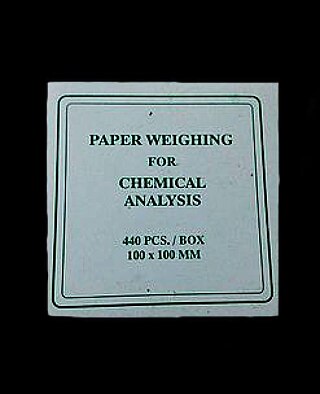
Weighing paper is often used when weighing solid, powdery substances on an analytical balance. By preventing the substance from making contact with unwanted materials, the precision of the measurement may be increased.
















